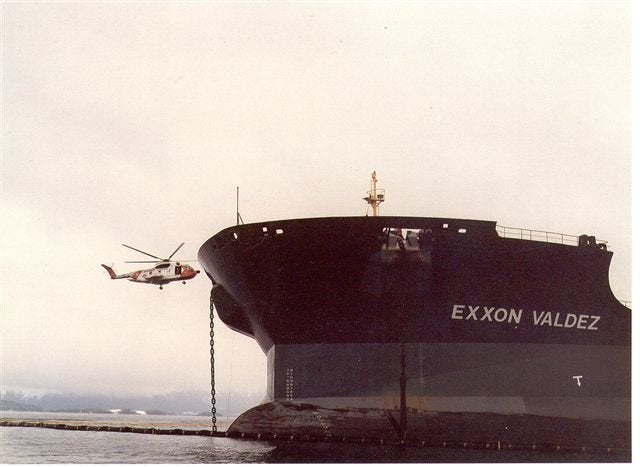
Hopefully, by now, you've already read the oil spill apocalypse pieces penned by our own Ryan Grim -- who documented "BP's Long History Of Destroying The World" -- and Sam Stein, who got the following diagnosis from a top lawyer in Exxon Valdez litigation: "[I]f you were affected in Louisiana, to use a legal term, you are just f--ked".
Well, here's something else depressing that you can add to your oil spill woes. The Exxon Valdez disaster, which occurred on March 24, 1989, played a major role in the collapse of the economy some 19 years later. See, as Stein documented, after lengthy litigation, Exxon managed to get the amount of punitive compensatory damages reduced from the hoped-for $5 billion to a paltry $500 million. But, back when Exxon had reason to imagine it might actually have to part with the $5 billion, the oil giant needed to find a way to cover its hindquarters. Exxon found a savior in the form of J.P. Morgan & Co., who extended the beleaguered company a line of credit in the amount of $4.8 billion.
Of course, that put J.P. Morgan on the hook for any potential judgment against Exxon. So the bank went looking for a way to mitigate that risk. Its solution made history, which you can read about in a June 2009 piece from the New Yorker's John Lancaster, entitled "Outsmarted." Here's the relevant portion:
In late 1994, Blythe Masters, a member of the J. P. Morgan swaps team, pitched the idea of selling the credit risk to the European Bank of Reconstruction and Development. So, if Exxon defaulted, the E.B.R.D. would be on the hook for it--and, in return for taking on the risk, would receive a fee from J. P. Morgan. Exxon would get its credit line, and J. P. Morgan would get to honor its client relationship but also to keep its credit lines intact for sexier activities. The deal was so new that it didn't even have a name: eventually, the one settled on was "credit-default swap."
So far, so good for J. P. Morgan. But the deal had been laborious and time-consuming, and the bank wouldn't be able to make real money out of credit-default swaps until the process became streamlined and industrialized. The invention that allowed all this to happen was securitization. Traditionally, banking involves a case-by-case assessment of the risk of every loan, and it's hard to industrialize that process. What securitization did was bundle together a package of these loans, and then rely on safety in numbers and the law of averages: even if some loans did default, the others wouldn't, and would keep the stream of revenue going, thereby diffusing and minimizing the risk of default. So there would be two sources of revenue: one from the sale of the loans, and another from the steady flow of repayments. Then someone had the idea of dividing up the securities into different levels of risk--a technique called tranching--and selling them off accordingly, so that riskier tranches of debt would pay a higher rate of interest than safer ones. Bill Demchak, a "structured finance" star at J. P. Morgan, took the lead in creating bundles of credit-default swaps--insurance against default--and selling them to investors. The investors would get the streams of revenue, according to the risk-and-reward level they chose; the bank would get insurance against its loans, and fees for setting up the deal.
There was one final component to the J. P. Morgan team's invention. The team set up a kind of offshore shell company, called a Special Purpose Vehicle, to fulfill the role supplied by the European Bank for Reconstruction and Development in the first credit-default swap. The shell company would assume $9.7 billion of J. P. Morgan's risk (in this case, outstanding loans that the bank had made to some three hundred companies) and sell off that risk to investors, in the form of securities paying differing rates of interest. According to J. P. Morgan's calculations, the underlying loans were so safe that it needed to collect only seven hundred million dollars in order to cover the $9.7-billion debt. In 1997, the credit agency Moodys agreed, and a whole new era in banking dawned. J. P. Morgan had found a way to shift risk off its books while simultaneously generating income from that risk, and freeing up capital to lend elsewhere. It was magic. The only thing wrong with it was the name, BISTRO, for Broad Index Secured Trust Offering, which made the new rocket-science financial instrument sound like a place you went to for steak frites. The market came to prefer a different term: "synthetic collateralized debt obligations."
As Lancaster notes: "Inevitably, J. P. Morgan's innovation was taken up by more aggressive and less cautious banks." Oh, you don't say!
Mortgage-based versions of collateralized debt obligations were especially profitable. These C.D.O.s involved the techniques that the J. P. Morgan team had developed, but their underlying assets were pools of mortgages--many of them based on the most lucrative mortgages, the now notorious subprime loans, which paid higher than usual rates of interest. (These new instruments could be pretty exotic: some consisted of C.D.O.s of C.D.O.s, pools of pools of debt.) J. P. Morgan was wary of them, as it happens, because it didn't see how the risks were being engineered down to a safe level. But institutions like Citigroup, U.B.S., and Merrill Lynch plunged in.
Flash forward to 2008, and there's widespread systemic failure that shreds the employment market and sends huge sums of wealth straight to Money Heaven.
So, something you might want to say the next time you hear someone lament that holding BP to account might lead to people losing their jobs is, "Well, I'll see you in 20 years, then, chum, on the breadline!"
Truly, these oil spill disasters are the gift that keeps on boning you, just as hard as the dickens.
[Would you like to follow me on Twitter? Because why not? Also, please send tips to tv@huffingtonpost.com -- learn more about our media monitoring project here.]
